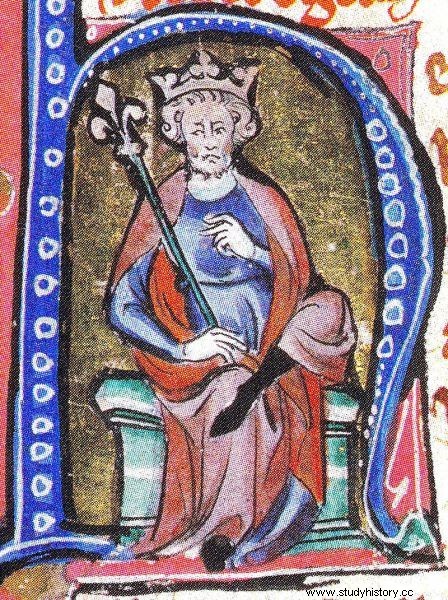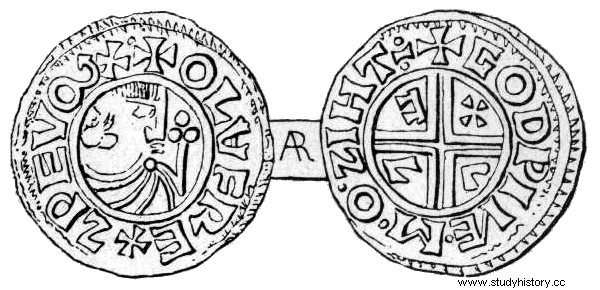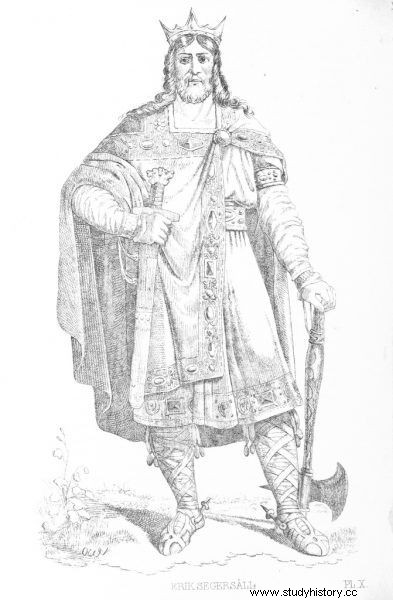According to some Polish crowned women, it was she, not Elżbieta Rakuszanka, who deserved to be called the mother of kings. Thanks to her, the Piasts sat on the thrones of Sweden, Denmark, Norway and England. And although historians do not agree that all the reports about the powerful daughter of Mieszko I, who shook all of Northern Europe, are true, about her equally powerful children they have no such doubts.
The biography of Świętosława (also known as Gunhilda or the Proud Signry), recreated on the basis of the few surviving sources and too many Nordic sagas, is unquestionably impressive. Polish princess, daughter of Mieszko I and Dobrawa (or according to another version - one of his pagan brides), she was the powerful and influential wife of two Viking rulers (Eric the Victorious and Sven Forkbeard), and her sons sat on the thrones of Sweden, Denmark, Norway and England.
The biography of Piastówna, which shook Northern Europe at the turn of the 10th and 11th centuries, could easily be attributed to several women. And - as modern historians believe - it would even be appropriate, because the history of Świętosława is in fact supposed to be a cluster of biographies of several different characters. So what is known about her?
The nameless princess
As the semi-legendary accounts say, she was brought to Scandinavia by her father, who was looking for allies. In the Swedish court, however, she quickly proved that she was not merely a pawn in the hands of men in power. It was she who was to persuade Eric to conquer Denmark (which earned him the nickname Victorious).
Later, not wanting to deny Christianity, she got rid of her husband and, as regent, on behalf of her underage son Olaf, ruled independently in Sweden. Numerous competitors strove for the widow's hand. But she dealt with them, inviting them to a feast in Uppsala, and then ... setting fire to the mansion, where there was a lot of fun.
Scorned and humiliated by her great love, the Norwegian ruler Olaf Trygwason, she married Sven Widłbeard in retaliation, and then gave him two sons:Canute (Knut) the Great and Harald. Meanwhile, she led to a battle of the three kings, during which Trygwason's fleet was routed. Her revenge is complete. At one point, her husband expelled her to Poland, but her loyal sons brought her back to the North after her father's death. She spent the last years as a queen-mother in England.

Knut the Great
This is what the sagas say, because information from surviving sources is much more scarce in this respect. Even the very name of the Polish princess sitting on the Nordic thrones is only the result of deduction (hence there are several versions of it), and the attractive hypothesis that identifies the Slavic wife of Sven with the widow of Erik the Victorious does not stand up to the results of historians' analyzes. Rafał T. Prinke comments:
Despite a hundred years of research, there is still no clear opinion on the case of Mieszko's daughter married to the Scandinavian kings. (...) It should be assumed that Mieszkówna was the wife of Swen Widłobrody and the mother of his sons Kanut and Harald. These facts are independently confirmed by Thietmar and Gesta Cnutoni, and also confirmed by the entry in Liber Vara (because only the daughter of a Słowianka could get the name of Świętosław).
It was not necessarily the same woman who earlier pushed Eric the Victorious to fight the Danes and bore him the heir to the throne, Olaf. But even if Mieszko I actually lived to see only two, not three crowned grandchildren in the North, it is still quite a good result. The more so because much more is known about the descendants of the Piasts ruling England and Scandinavia than about their nameless mother.
The three kings of the North
Undoubtedly, the youngest son of Świętosław - Canute called the Great - was the most vivid in the collective imagination. In the years 1013–1014, along with his father, he went to England, and after Sven's death, he did the work on his own, in 1016 taking over the whole country and becoming its king. He ruthlessly dealt with his opponents:he expelled members of the Anglo-Saxon ruling family, and ordered to murder the opposing nobles.
In 1018, after the death of his brother, he took over Denmark, and in 1028 he conquered Norway (he expelled King Olaf II), creating a vast and strong - though, as it was soon to be ephemeral - empire in the North. Jakub Morawiec writes:
He inherited from his predecessors, father Svena Widłbeard and grandfather Harald Bluetooth, his ambitions and aspirations to dominate Scandinavia and to consolidate English gains, with the crown at the fore. Knut not only skilfully referred to the achievements of his ancestors, but also significantly developed them (...).
Determination, personal talents and a group of advisers (especially important in the first phase of government) were the main factors that influenced the success of Sven Widłbeard's rule. This ruler with equal success in eliminating political opponents (even members of his own family) and publicly manifested humility, piety, and a willingness to repent of his sins.
And although his so-called North Sea empire fell apart shortly after his death, he was undoubtedly an outstanding figure. Against this background, the fate of the other descendants of the Piasts on the thrones of the North is much worse.

A silver medal that was minted by Olaf Skötkonung.
There is little source material about the elder son of Sven and Świętosława, Harald. It is known that he ruled Denmark from 1013 - initially as regent (when his father and younger brother fought with the English), and later as a king. Against the will of Forkbeard, who chose Canute as his successor. Even though Harald refused to hand over the Danish throne to his rightful heir, it seems that the brothers lived rather in harmony. The older one supported the younger one in his conquests, they also went to Poland to bring home their exiled mother.
A little more information has been preserved about the alleged firstborn son of Świętosław, who came from a marriage with Eryk the Victorious. Rafał T. Prinke reports:
Eric's son was Olaf Skotkonung (Skötkonung), probably named after the tribute he had made in the coin that he struck at Sitgun in Gorland. He took power after his father's death in 994/995; he returned Denmark to Swen Forkbeard, in alliance with him, in 999/1000 defeated the king of Norway, Olaf Trygwason in the "Battle of the Three Kings" at Svold (near the island of Zealand). (...) He was baptized in 1009 and died in 1021/1022.
According to one legend, he died in tragic circumstances - after a faithful Christian refused to make a pagan sacrifice (he was to be considered a saint for this martyr's death).
Is it raining an apple near an apple tree?
One should not forget about the daughters of Świętosława, although their biographies - compared to the turbulent fate of their mother - are very "ordinary".
Virtually nothing is known about Holmfried, who was born to Eryk the Victorious. The greatest achievement of Estryda-Małgorzata (coming from a relationship with Swen Widłbeard) was to marry the Jarl of East Anglia, Ulf Torgilsson and bringing into the world the future King of Denmark, Sven II Estrydsen. On the other hand, the youngest, Świętosława (also the daughter of Widłobrody), appears in only one mention - written by a religious priest, Elfsig Liber Vita from New Minster in Winchester, dated 1031. Rafał T. Prinke reports:
Among the benefactors of the church there is mentioned King Canute's sister named Świętosław (Santslaue). Before her name, as before the names of other people, the letter h was added in a later hand, which probably means hic and indicates her burial in this early royal necropolis, next to Alfred the Great and his successors. This is the only known source mention of Świętosław, but its credibility cannot raise any doubts, as it was created during the lifetime of King Canute, and perhaps also during her lifetime.

Eryk the Victorious
On this basis, the researchers "recreated" the name of Mieszko's daughter, recognizing that the daughter was named Świętosław after her Slavic mother. However, this would not be in line with the Scandinavian customs of the time, which did not allow children to be named after their still living ancestors.
As you can see, the achievements of Świętosława's children in comparison with her own (if you take into account everything that tradition has attributed to her) are not very impressive - maybe except for the successes of Canute the Great. Well, at least one apple actually fell not far from the apple tree…
